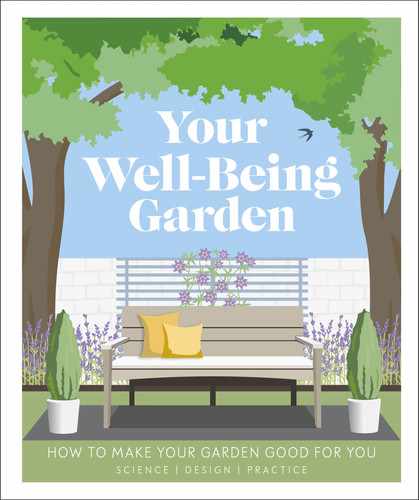
113
112
THEHEALINGGARDEN
No matter how small your outdoor space, you
can usually nd room for a simple water bowl.
Placing it on the ground or sinking it into the soil
draws in reections of the sky and surrounding
plants, and creates a watery surface that can
become a focus for contemplation. If space is
limited, you can place a small water bowl on a
table. Delicate ower petals oating on the
surface will add a splash of color.
To maximize reections, make the surface
area as wide as you can. Dark sides and a dark
base make the reections clearer, or you can
add a black nontoxic dye to the water, which will
have the same eect and will help to prevent
algae growing. Obscuring the bottom of a bowl
or pool also creates an illusion of depth.
DESIGNWITHWATER
FORWELLBEING
Choose a material for your bowl that goes with
the style of your garden. Stainless or weathered
steel or copper will suit a contemporary or formal
space, while cast stone or ceramic will look good
in a rural or cottage garden.
Replenish the water frequently to keep it
clean and clear. Use harvested rainwater rather
than tap water, which can contain chemicals. A
pump tted to larger bowls and basins will keep
the water clear and create the gentle sounds of
moving water. For the most energy-ecient
option, use a solar pump. The design of some
bowls allows for the water to spill gently over the
edge into a hidden reservoir, creating a moving
curtain of water that is endlessly fascinating
(see p.72). In others, the movement of ripples,
swirls, or bubbles on the surface of the water
draws the eye.
Creating calm
If you have the space, bring a sense of peace
and calm into the garden with a rill (see p.114). A
stone or brick rill blends in well in informal
gardens; the clean lines of steel and slate suit a
more contemporary space. For a small garden,
a straight line makes the best use of space. In a
larger garden, a more winding, organic shape
allows you to conceal the full course of the rill,
encouraging visitors to explore.
Even a small space can have a water
feature that adds both sound and
animation. A simple pump can circulate
the water for a gentle and constant ow.
US_112-113_Water.indd 112 13/11/2019 15:34

113
THE RESTORATIVE EFFECTS OF WATER
112
THE HEALING GARDEN
The gentle, trickling sounds of a rill, like a natural
stream, can be soothing to tired minds. Create
a gentle downward ow by placing it on a slope.
Line the base of the channel with a smooth
material, such as contemporary-looking cut
stone or steel, to create an even ow, or use
riven stone or pebbles to give the water a livelier
movement and sound.
At the end of the rill, the water can either
feed into a reservoir, from where a pump takes it
to the top of the slope, or it can fall into a pool or
trough to create the splashing sounds of a
waterfall, which can help to mask unwanted
noise (see p.38). Screen this lower pool with
plants to introduce an element of mystery into
your garden.
Reections in a large bowl mirror
the surrounding plants, enlarging
the sense of space and creating an
atmosphere of tranquillity.
The clean,
straight lines of
this rill contrast
with the striking
foliage around it.
Falling water and green foliage
create a soothing environment for this
seating area. The waterlilies add visual
interest and are likely to attract wildlife.
US_112-113_Water.indd 113 13/11/2019 15:34

114
115
Even the smallest of spaces
has room for water. A bowl is
a simple way to enhance a
balcony, terrace, or courtyard.
An expanse of water allows
light to bounce around the
garden and reect the
details of plants
A simple bowl of
water can have
restorative
qualities
Falling water can provide
a gently soothing sound
A repeating pattern
of yew domes adds
rhythm and structure
US_114-115_Matt_Water_Garden.indd 114 13/11/2019 15:34
..................Content has been hidden....................
You can't read the all page of ebook, please click here login for view all page.
